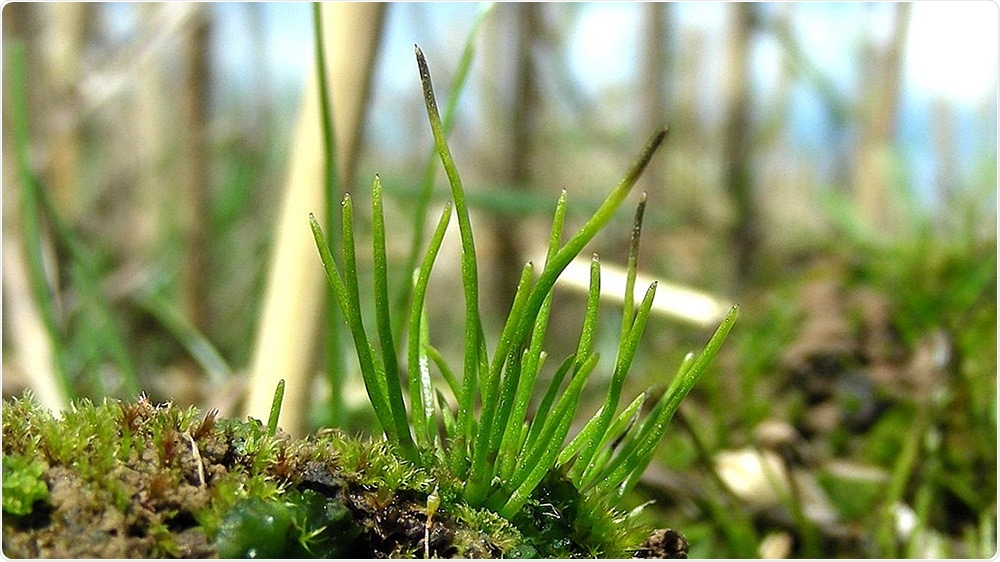By examining the first hornwort genomes, an international team of researchers headed by the University of Zurich (UZH) and the Boyce Thompson Institute has shed light on the origin of land plants.

Hornworts belong to the oldest still existing land plants. Image Credit: Michael Lüth.
Genes identified by researchers in this ancient group of land plants could aid more efficient growth of crops, without the use of excessive synthetic fertilizer.
About 500 million years ago—when a majority of life thrived underwater and the continents were linked in a single landmass—one of the first groups of plants to colonize land was hornworts (Anthoceros).
The international research team has currently sequenced three genomes of hornwort, shedding light on the genetics involved in the special biology of the group, an exact representation of the ancient group of land plants. The researchers started the project in 2011.
It took us three years to figure out how hornworts can be grown and pushed through its sexual life cycle under laboratory conditions, and another three years to properly assemble and annotate its genome.”
Péter Szövényi, Study Last Author and Researcher, University of Zurich
Higher crop yields with less fertilizer
One of the goals of the scientists was to identify genes that have a role to play in hornworts’ way of concentrating the carbon dioxide gas within chloroplasts, which increases the ability of plants to make sugar and result in a better yield.
About this capability, hornworts are exceptional among the group of land plants but the trait is also shared by certain algae species.
Hence, the scientists compared the genomes of hornworts against those of algae and identified a single gene called LCIB. This gene is shared by the two plant groups but not with other groups of land plants.
If this carbon-concentrating mechanism could be installed in crop plants, then they could grow larger with the same amount of fertilizer.”
Fay-Wei Li, Study First Author and Plant Biologist, Boyce Thompson Institute and Cornell University
Symbiosis with bacteria to acquire nitrogen
Hornworts also live in symbiosis with cyanobacteria and fungi, offering nitrogen and phosphorus to the plant.
Also, the team detected 40 genes that are likely to promote the source of nitrogen of hornworts. This nitrogen comes from an interdependent association with cyanobacteria—a special trait found in land plants.
“If this capability of hornworts can be transferred to crop plants, many tons of nitrogen fertilizer could be saved,” added Szövényi.
Reduced use of fertilizer can benefit the environment because a surplus amount of agricultural nitrogen often ends up in waterways, where it can encourage the growth of harmful algal blooms.
Both Szövényi and Li are already performing a study to interpret the genetic mechanism involved in the interaction between cyanobacteria and symbiotic plants.
Illuminating the origin of land plants
The study also provided an understanding of the evolution of the ancient group of land plants. In the absence of stomata, a majority of the plants cannot absorb carbon dioxide and survive in the terrestrial setting. Hence, stomata denote a breakthrough in the colonization of the terrestrial setting.
But so far, it was not known whether stomata had evolved singularly or potentially many times separately in the group of land plants. During their spore-producing phase, hornworts typically have stomata.
“We found that the basic genetic toolkit governing stomatal development in flowering plants is shared with hornworts,” Szövényi added.
This latest discovery is consistent with the concept that stomata had emerged only once in the latest common ancestor of land plants.
Mosses, liverworts, and hornworts are one of the first plants to colonize land, but the association between these three groups was not clear before.
Our research shows clearly that hornworts, liverworts and mosses are all more closely related to each other than they are to vascular plants. We also show that liverworts and mosses are more closely related to each other than to hornworts.”
Fay-Wei Li, Study First Author and Plant Biologist, Boyce Thompson Institute and Cornell University
Source:
Journal reference:
Li, F.-W., et al. (2020) Anthoceros genomes illuminate the origin of land plants and the unique biology of hornworts. Nature Plants. doi.org/10.1038/s41477-020-0618-2.